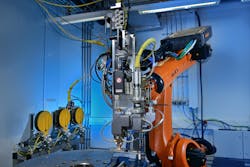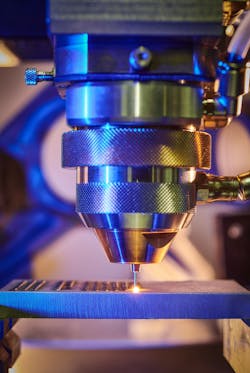Wire laser material deposition process saves costs
Conventional manufacturing processes such as turning, milling, eroding, or forming are gradually reaching their limits whenever large and complex individual metal components need to be manufactured. While additive manufacturing processes offer significant advantages in terms of saving raw materials, they still have low deposition rates. So, it makes sense to consider combining conventional and additive manufacturing processes.
As part of the collaborative ProLMD project, funded by the German Federal Ministry of Education and Research (BMBF), the Fraunhofer Institute for Laser Technology (Fraunhofer ILT; Aachen, Germany) is working with industrial partners to develop new processes for integrating hybrid laser material deposition (LMD) processes into the production chain. For example, one aim is to develop processes and systems that can be used to apply reinforcements or other geometric features onto cast or forged blank parts via LMD.
Developed at Fraunhofer ILT and now implemented in the ProLMD project, the new ring-shaped beam plays an important role in coaxial LMD with wire, providing directional independence. Combined with the low-cost filler material wire and a nearly 100% utilization, overall costs can be reduced drastically.One of the main features of the new processing optics is uniform intensity distribution of the laser beam intensity over the ring. Wire LMD can be used to manufacture components with very high quality, without pores, and with extremely low post-processing requirements. In addition, the new head enables welding on 3D surfaces. The new optics will be integrated into a process chain that improves the quality of the other components, thanks to intermittent scanning.
For more details, please contact [email protected].
Got laser processing-related news to share with us? Contact David Belforte, Editor in Chief, Industrial Laser Solutions.
Get even more news like this delivered right to your inbox

